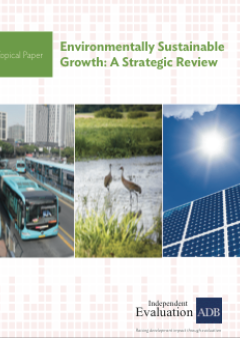
ADB's Environmentally Sustainable Growth Agenda: A Strategic Review
The Asian Development Bank's (ADB's) long-term strategic framework issued in 2008, Strategy 2020, identified environmentally sustainable growth (ESG) as one of ADB's three main strategic agendas. It also highlighted the environment as a core area of operations, while it paid special attention to three environmental areas: (i) climate change—mitigation and adaptation; (ii) livable cities; and (iii) "complementary actions,” including the mainstreaming of environmental considerations into country policies and investment programs, while strengthening the legal, regulatory, and enforcement capacities of public institutions.
This paper assesses ADB's response to this strategic agenda and raises issues for consideration in the ongoing discussions on the next corporate strategy of ADB, Strategy 2030.
For ADB to realize its potential as the environmental sustainability bank it should build on the examples and lessons highlighted in the paper. More effort will be needed to use the CPS as the framework to operationalize the SDGs and the Paris Agreement commitments in country contexts and to integrate more cross-sectoral and spatial approaches to support ESG. IED encourages ADB to shift to operations with more innovative and impactful environmental content. In the meantime, ADB is well advised to give more strategic direction on ESG.
Focusing on this immediate need, the paper makes two primary recommendations for consideration to further the ESG agenda:
- Future ADB strategies and policies, in particular Strategy 2030, should further elaborate what ESG means and what its pursuit implies for ADB
- Better categorization and targets for ESG operations are needed as ADB's environment agenda expands and is further integrated into its operations
